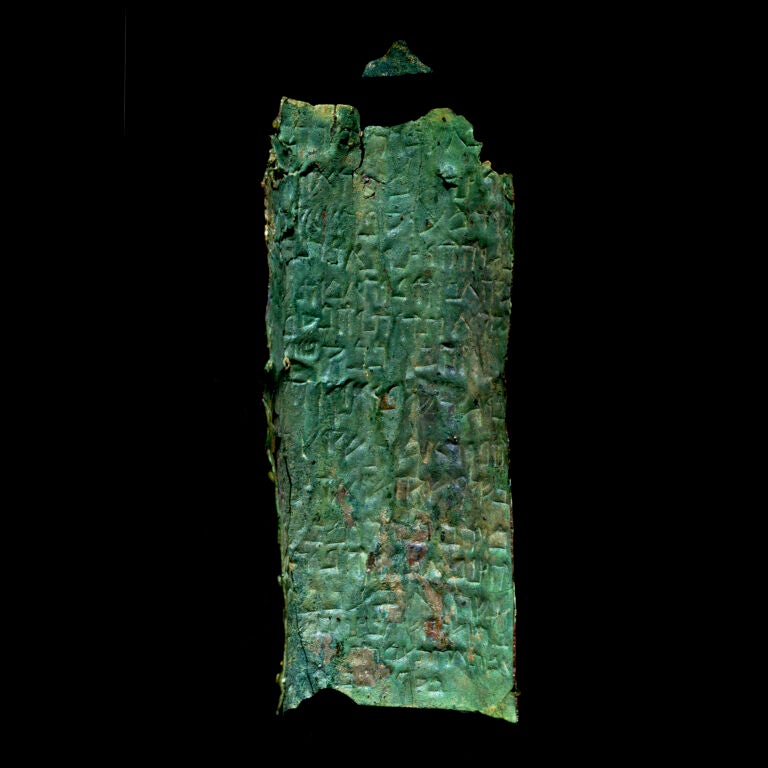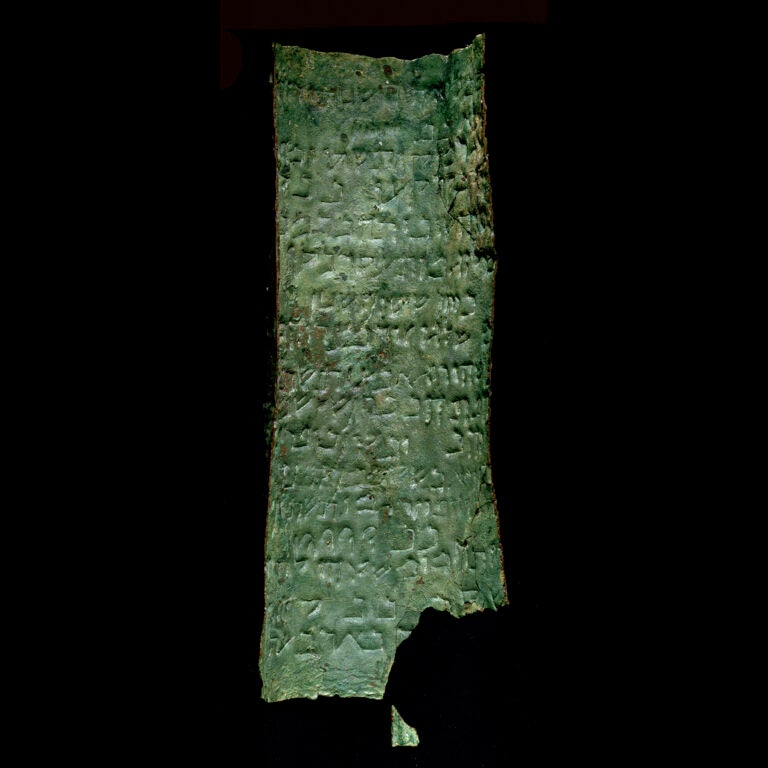The Copper Scroll (3Q15)
“In the fortress which is in the Vale of Achor, forty cubits under the steps entering to the east: a money chest and it [sic] contents, of a weight of seventeen talents.” So begins the first column of the Copper Scroll, one of the most intriguing, and baffling, scrolls to be found among the collection known as the Dead Sea Scrolls. Sounding like something out of an Indiana Jones movie, the text of the Copper Scroll (3Q15) describes vast amounts of buried treasure. It was found in 1952 in Cave 3 at Khirbet Qumran on the shores of the Dead Sea, one of the few scrolls to be discovered in the place where it had lain for nearly 2,000 years. Most of what is called the “Dead Sea Scrolls” were found by Bedouin and sold through antiquities dealers, but this one was actually discovered by archaeologists–a rare occasion during those years. In ancient times the text of the document had been incised on thin sheets of copper which were then joined together. At the time it was found, however, the document was rolled into two separate scrolls of heavily oxidized copper which were far too brittle to unroll. For five years scholars and experts discussed ways of opening the scroll. Finally, they decided to cut the scroll into sections from the outside using a small saw. Working very carefully they cut the scroll into 23 strips, each one curved into a half-cylinder. Before it was cut, one scholar thought he saw words for silver and gold and suggested that the scroll was a list of buried treasure. Sure enough, when it was deciphered that scholar turned out to be right!
Photograph by Bruce and Kenneth Zuckerman, West Semitic Research, in collaboration with Princeton Theological Seminary. Courtesy the Department of Antiquities, Jordan.

Treasure
What about all that treasure? What is it? Has anyone found it? The answer to the last question is, no, at least that they are telling.
The treasure described in the Copper Scroll consists of vast quantities of gold and silver, as well as many coins and vessels. It is difficult to assess the value of what is described since we are not sure what the weights in the scroll are actually equivalent to, but it was estimated in 1960 that the total would top $1,000,000 U.S.
With this great treasure list, you may ask, why isn’t everyone out looking for the treasure? (And why hasn’t Stephen Spielberg made a movie out of it?) The truth is, some people are looking for it, but it is not all that easy. To begin with, we do not know what all the words in the text mean. The text is in Hebrew, which is certainly a known language, but most ancient Hebrew texts that we have are religious in nature, and the Copper Scroll is anything but religious. Most of its vocabulary is simply not found in the Bible or anything else we have from ancient times.
Not only is the vocabulary of the scroll very technical, some of the geographical locations are unknown after so many years, many are too specific and some refer to places that no longer exist. Take some of the following examples:
“In the gutter which is in the bottom of the (rain-water) tank…”
“In the Second Enclosure, in the underground passage that looks east…”
“In the water conduit of […] the north[ern] reservoir…”
There are those who have suggested that the treasure never actually existed, that the Copper Scroll is simply a work of fiction. Even if the treasure did exist, we do not know where it came from or who it belonged to. Some believe the scrolls refer to Temple treasure, hidden for safekeeping before the destruction of the Jerusalem Temple in 70 C.E. Others believe the treasure belonged to the sect that lived at Qumran, a sect usually identified with the Essenes, a Jewish group mentioned in the work of the Jewish historian Josephus, who wrote in the 1st century C.E. However, these are just educated guesses. Who the treasure belonged to, and what happened to it, we may never know.

Articles
- Discovering the scrolls The finding of the Dead Sea Scrolls.
- Testimonia An anthology of Bible verses concerning the Messiah.
- Isaiah Pesher An ancient commentary on the book of Isaiah.
- The Rule of the Congregation Rules for living in the Messianic age.
- Copper Scroll A list of buried treasure.
- Qohelet Fragments from the Book of Ecclesiastes.
- The Words of Moses A document using themes from the book of Deuteronomy.
Article Categories
Non-Biblical Ancient Texts Relating to the Biblical World: Non-biblical inscriptions and documents from ancient times that improve our understanding of the world of the Bible.
Biblical Manuscripts: Images and commentary on ancient and medieval copies of the Bible.
Dead Sea Scrolls: Images and commentary on selected Dead Sea Scrolls manuscripts.
USC Archaeology Research Center: Images of artifacts from the teaching collection of the University of Southern California.